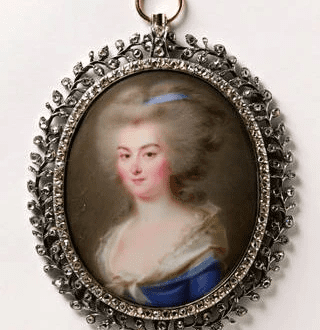While many of art history’s most renowned paintings are on a massive scale, tiny paintings provide us with a strong and evocative glimpse into bygone lives. Miniature paintings were appreciated for their technical skill and mobility in a world before photography, and they played an important role in both personal and diplomatic ties.

The History of Miniature Portraits
Miniature painting has its roots in mediaeval illuminated manuscripts, which were illustrated with the pigment known as minium. Throughout the Middle Ages and throughout the Renaissance, illuminated manuscripts were highly esteemed. They were forced to compete with printed books following the advent of the printing press in 1440. As a result, painters who specialise in illumination, such as the Flemish painter Simon Bening (c.1483–1561), began to diversify their revenue by creating separate tiny paintings for customers, either as objects of devotion or as luxury commodities to be enjoyed by connoisseurs.

Portrait Miniatures in their Golden Age
Jean Clouet (1480–1541) and Lucas Horenbout (c.1490–1544), two Netherlandish artists, began painting portrait miniatures for the courts of Francis I in France and Henry VIII in England in the 1520s. European rulers used portrait miniatures as diplomatic presents or to thank loyal courtiers, as well as in marriage negotiations. They were then encased in precious mounts and worn as signs of devotion to Elizabeth I’s court, and they were adopted more broadly by the elite to serve as emblems of friendship or affection.

Portrait Miniatures Boom
Early miniatures were generally painted in watercolour and gouache on vellum, but in the 17th century, French painters began to paint in enamel on metal surfaces, while Rosalba Carriera (1673–1757), a Venetian artist, began to paint on ivory in approximately 1700. This invention swept through Europe, rekindling interest in miniature painting, especially among amateur painters who saw the medium as a refined leisure.
A growing income led to a broader market for portrait miniatures from the late 18th century forward, notably in England, where several new painters provided clients likenesses of family and loved ones in regional centres such as Liverpool. British artists such as John Smart, Ozias Humphry, and Diana Hill even travelled to India, where they painted East India Company personnel and their families to great acclaim.
The Decline of Portrait Miniatures
With the invention of photography in 1839 provided a larger public with more inexpensive and realistic likenesses, posing a challenge to painters once again in the nineteenth century. Many artists who worked at the lower end of the market became photographers or were obliged to make a living by colour-tinting black-and-white images. Miniaturists were few and far between by the mid-nineteenth century, and miniatures were rarely shown at the Royal Academy.
Painting & Photography Rivalry for Portraits
Despite the fact that photography obviated the need for portrait miniatures, attempts to resurrect the art form began in the second half of the nineteenth century. The South Kensington Museum (now the Victoria and Albert Museum) had an ambitious miniatures show in 1863, and the Society of Miniature Painters was formed in London in 1896. The Royal Society of Miniature Painters, Sculptors, and Gravers, which was granted a Royal Charter in 1904, continues to thrive today as the Royal Society of Miniature Painters, Sculptors, and Gravers, which hosts an annual show of over 700 pieces.
Artists nowadays respect and appreciate the virtuosity necessary to paint on such a small scale, adapting miniature painting methods to show a far broader range of topics, including landscapes, still lifes, animals, and botanical art.
Where are Miniature Portraits at Today

Some artists today still carry on this amazing skill into the modern-day, although it may not play as much of an important role in personal and diplomatic ties, and may not be as popular, there are many artists out there who do these paintings, either for themselves and the technical skill, or to take on commissions. I can think that this would be a very nice birthday gift to give to someone.
Information Citations
En.wikipedia.org, https://en.wikipedia.org/.
Recommend0 recommendationsPublished in Art History, Resources


Responses